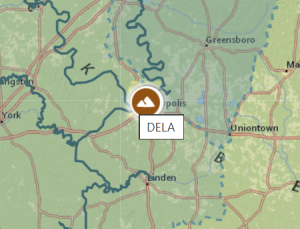NEON Operations coming to a close at Dead Lake, Alabama, field site
October 15, 2025
NEON operations are coming to a close at the Domain 08 (D08; NEON Ozarks Complex Domain) terrestrial gradient site in Dead Lake, Alabama, (DELA), per the request of the site host. The Terrestrial Instrument System (TIS) data collection (including the flux tower and soil arrays) was discontinued on Oct. 6, 2025, as the decommissioning of the site was initiated. Terrestrial Observation System (TOS) data collection remains ongoing but will be complete by the end of calendar year 2025. All IS data collected through Oct. 6, 2025, and OS data collected through Dec. 31, 2025, will remain available on the NEON Data Portal and Biorepository Data Portal for the life of NEON. Airborne Observation Platform (AOP) data will continue to be collected.
DELA is a seasonally-flooded hardwood bottomland in Greene County, Alabama that has been sampled by the NEON program since 2013. It is located in an area called the "Blackbelt," an area known for its nutrient-rich, dark soil, and is co-located with the aquatic site Black Warrior River (BLWA). NEON operations are planned to continue at BLWA, although two groundwater wells will be removed. The Airborne Observation Platform (AOP) data will continue to be collected over the DELA footprint as part of the BLWA data collection. D08 operations will continue at the other two terrestrial sites in the Domain, the core site in Talladega National Forest NEON (TALL) and the gradient site, Lenoir Landing NEON (LENO), as well as the two other aquatic sites, Mayfield Creek NEON (MAYF) and the Lower Tombigbee River NEON (TOMB).
The NEON program appreciates the 12 years of support from the site host, the U.S. Army Corps of Engineers, throughout its construction and operations. NEON plans to complete the decommissioning and site remediation activities in 2026. The Corps has indicated their plan to continue managing the area for wildlife habitat and hunting.
For further inquiries, please use the Contact Us form.
